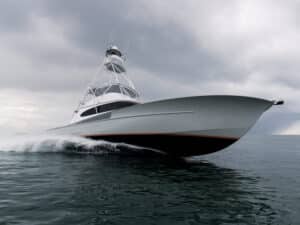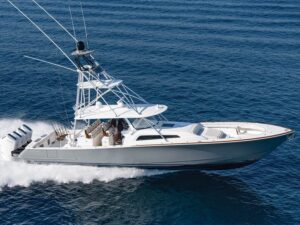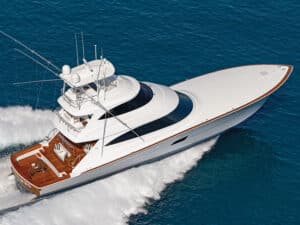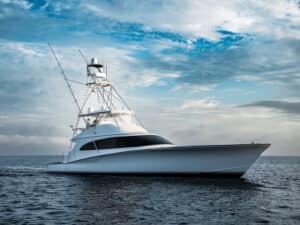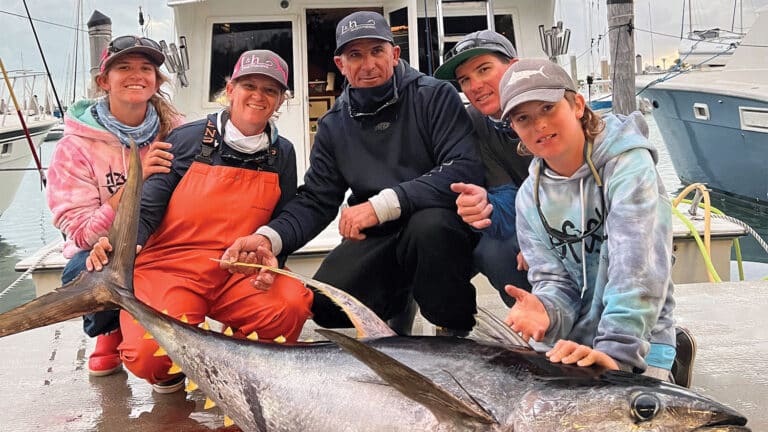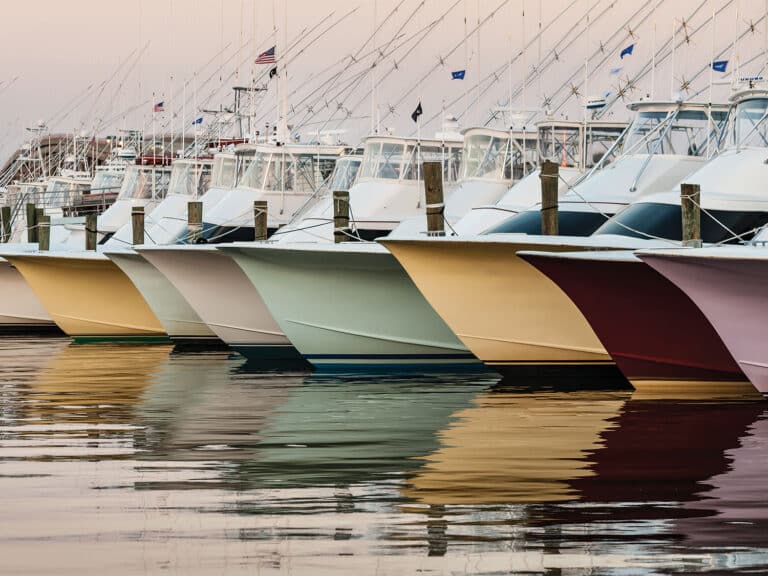
Salthouse60_1
I understand how averse to change sport fishermen are. Sometimes, though, I see innovations that convince me that our boats could be much more interesting and our lives more comfortable if we entertained some minor changes in our boating philosophies. When I first walked aboard the Salthouse 60, conceived and built in New Zealand, this thought really struck home. I have never seen an interior layout as radically different (nor as logical) as this in a sport-fishing convertible. It works infinitely better than the standard American plan. And yet, the difference is so slight as to be laughable. I’d love to see some American builders adopt this layout.
PERFORMANCE
Americans live in a glorious bubble of great prosperity and the lowest fuel prices in the world. The first Salthouse 60 hull to arrive on our shores came powered with incredibly economical Yanmar 420-hp diesels. It ran at a perfectly comfortable top speed of 26 knots at 2,600 rpm in calm water and cruised at 22.8 knots at 2,400. Cruising at 20 knots sipped a remarkable 30 gph. With that said, Salthouse also supports the American attitude of ”Damn OPEC – full speed ahead!” with 1,050-hp MAN engines to get the top end up over 30 knots. Caterpillar packages are also available.
The Salthouse exhibits no bow rise at all when you put the throttles forward, and it produces a very clean wake, denoting an efficient running surface design. At speed, I would categorize its turning ability as stately; put the wheel hard over and the boat turns, but not in what I would describe as a tight arc. Of course, I’d be willing to bet that with bigger engines and at higher speeds, turning would be improved for the same size rudders. All in all, the Salthouse 60 provides a comfortable, stable ride with remarkable roll stability. If you want a boat that makes you feel like you aren’t moving, this is it.
The 60’s close-quarters handling qualifies as nothing short of superb. Totally predictable reactions to every command mean you’ll have no handling idiosyncrasies to deal with. The Salthouse sits where you put it.
**FISHABILITY
**Both the 60- and the 65-foot Salthouse models have larger cockpits than many comparable American vessels, so you can mount your choice of fighting chair(s). Unfortunately, our test vessel, being a newly arrived brokerage boat, had yet to be rigged for fishing. However, the factory confirms that a baitwell and rigging station can be fitted, and you can choose large fish boxes or lazarette access through the cockpit sole. As I said earlier, the Salthouse has a particularly clean wake, and for drift-fishing you couldn’t ask for a steadier platform. The underwater exhausts make for an unusually quiet ride both in the cockpit and salon while trolling and running.
Moving forward to fight fish West Coast-style couldn’t possibly be more secure, thanks to full nonskid and an extra-tall, heavy-duty stainless-steel rail. You can also easily climb down into the anchor locker.
FLYBRIDGE
Designer Bob Salthouse offers the 60 only in enclosed-bridge configuration. However, you can choose either internal or external access – both via a secure-feeling semicircular staircase.
We started out with winds out of the southeast at about 10 knots. Passing through prefrontal squalls, winds picked up to about 25, and the attendant 3- to 4-foot seas we encountered created the only conditions in which I prefer an enclosed bridge. But it’s hard to argue with the comfort of these boats. Besides, the Salthouse’s large sliding windows on each side and overhead hatches afford plentiful ventilation if you prefer fresh air to air conditioning.
Optional aft controls allow the skipper to maneuver with unobstructed views of the cockpit and fish. With large windows all around and about the forward third of the bow visible from the aft-situated helm, you’ll have no vision problems when docking and driving.
INTERIOR
The interior is where you’ll find the lion’s share of logical innovation on the Salthouse 60. First, with a day head just outside the cockpit door, guests and crew can’t track anything through the salon when they visit the water closet. Likewise, the galley has been placed all the way aft, next to a huge cockpit window. When it’s time for lunch, the mate need never step on carpet to make sandwiches. Besides, when under way, the farther aft you go, the calmer the boat’s motion. Ergo, it’s easier to work an aft galley than a forward one.
One of my biggest complaints about today’s convertibles is the lack of dining area. You practically need to eat all formal meals on TV trays because the dinette can seat only two or three normal-sized people. The Salthouse lines all have mammoth dining tables that can seat 10 or 12 comfortably without detracting at all from the comfort of the salon.
The belowdecks layout boasts three staterooms, with the master all the way forward. Its queen-sized island berth sits on centerline and is complemented with an elegant private head with shower. An athwartship double cabin just aft to port, a starboard-side head without a shower and over/under berths to starboard round out the accommodations. The television faces forward in the entertainment section so that people walking down the dock as you are backed in don’t view along with you.
ENGINE ROOM
Interestingly, the main engine room is accessed from the forward cabin areas through the salon steps. The transverse bulkhead with a watertight door makes for a bit of a tight squeeze for someone of my considerable size. Once inside, the engine room provides sitting headroom only, though you’ll find loads of room to work all the way around both engines. And if your mate wants to do the laundry, a tight washer/dryer compartment precedes the watertight bulkhead beneath the stairs.
CONSTRUCTION
Salthouse employs an interesting construction feature. It uses only clear vinylester resins on the bottoms so you can actually see any lamination voids in addition to preventing osmotic blistering. After the boat is pulled from the mold and inspected, bottom paint covers the fiberglass. Salthouse utilizes end-grain balsa coring throughout the hull for strength without excess weight. Four full-length girders augment the stringer system that runs the length of the hull. Finally, each hull and deck are independently surveyed and inspected for integrity by Lloyds of London.
I believe this to be one of the most logical and comfortable interiors of any boat on the market today. You simply have to see it yourself to appreciate it.
